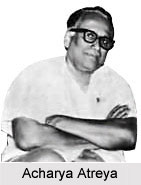 Acharya Atreya was a prominent actor, director and playwright in the history of Indian theatre. He was born in the year of 1921. His ten full-length and fifteen one-act scripts helped succeeding generations of dramatists in Andhra to define, formulate, and execute the theatre of protest. This Telugu theatre personality wrote plays as a student in Nellore and Chittor but left studies to join the Quit India movement and went to prison. Acharya Atreya was adjudged best director at the Andhra Nataka Kala Parishath`s first competition, for a production of Kondamudi Gopalaraya Sarma`s Eduritha i.e. "Swimming against the Current" in 1945.
Acharya Atreya was a prominent actor, director and playwright in the history of Indian theatre. He was born in the year of 1921. His ten full-length and fifteen one-act scripts helped succeeding generations of dramatists in Andhra to define, formulate, and execute the theatre of protest. This Telugu theatre personality wrote plays as a student in Nellore and Chittor but left studies to join the Quit India movement and went to prison. Acharya Atreya was adjudged best director at the Andhra Nataka Kala Parishath`s first competition, for a production of Kondamudi Gopalaraya Sarma`s Eduritha i.e. "Swimming against the Current" in 1945.
Career in Theatre for Acharya Atreya
Acharya Atreya`s first extant play i.e. his earliest works, Santi and Dr Kotnis, are lost, this supposedly inspired by Bernard Shaw`s "The Adventures of a Black Girl in Her Search for God", which has as its theme Gautama becoming the Buddha after a long search for a new world order. The next play, Ashok Samrat i.e. "Emperor Asoka" in 1944, shows the warmongering Asoka forced to realize the worth of peace, a recurring theme in Atreya.
Parivartana i.e. "Change" in 1945 is on capitalistic exploitation of both physical and mental labour. Two political satires followed as Vastavam i.e. `Reality` in 1946 and Inadu i.e. `This Day` in 1947. These two projected the nature of the new brand of politicians and the Hindu-Muslim conflict respectively. His trend-setting next play, N.G.O. in 1948, introduced protest drama in Telugu language with an angry young man as the hero. Among later important works Viswasanti i.e. `World Peace` in 1951, on the capitalist exploiters who invite war, Kappalu i.e. `Frogs` in 1953, on people flocking where riches abound and Bhayam i.e. "Fear" in 1954, on the fear complex in people, achieved great success on stage. Atreya`s one-act scripts, like Yevaru donga i.e. `Who`s the Thief?" in 1951, are also protest plays of great theatrical intensity. In later years, Acharya Atreya attained eminence as a composer of lyrics and scenarios for Telugu cinema, starting with the melodramatic Samsaram i.e. `Household` in 1950 and Nirdoshi i.e. `Innocent` in 1951, then adapting N. G. O. into Gumasta i.e. `Clerk` in 1953, and scripting the devotional hits, Sri Venkateshwara mahatyam i.e. Balaji in 1960 and Chakradhari in 1977.
This legendary Telugu theatre personality died in the year of 1989.




















